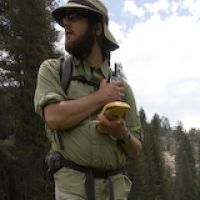Sierran Montane Meadows; Conklin
PRESENTATION/TALK | MEETING/CONFERENCE
Montane meadows as a window into groundwater processes in Sierra Nevada Catchments
CCC Rm 207, Denver. CO
-
Sierra, INVESTIGATOR
-
Sierra, GRAD STUDENT
Presentation details at Geological Society of America, 2013 Annual Meeting
Session No. 389
T53. Mountain Groundwater: Recent Advancements in the New Era of Climate Change and Resource Development
Wednesday, 30 October 2013: 1:00 PM-5:00 PM
Colorado Convention Center Room 207
Geological Society of America Abstracts with Programs. Vol. 45, No. 7, p.862
See overview of SSCZO activity at GSA 2013. Abstract in the GSA meeting program.
Abstract
CONKLIN, Martha H. and LUCAS, Ryan G., Sierra Nevada Research Institute, University of California, Merced, 5200 N Lake Rd, Merced, CA 95343, mconklin@ucmerced.edu
Montane meadows of the Sierra Nevada Mountains are often characterized by low gradient and shallow groundwater tables for much of the year. We exploit these conditions in order to understand the connection of meadow processes to the groundwater dynamics of the greater catchment. Our hypothesis is that meadow groundwater fluctuations integrate watershed processes with meadow specific processes. We utilize a series water column data from monitoring wells and piezometers in two meadows and deeper wells adjacent to the meadow edge, soil moisture and snow depth data from nodes in the associated catchment located within the Southern Sierra Critical Zone Observatory, from water years 2008-2012. Water samples from wells and associated streams were analyzed for major ions and stable water isotopes. Results indicate spatial heterogeneity of groundwater flux and contribution to evapotranspiration (ETg) across the meadows. Near the meadow center, groundwater flux indicates discharge for the duration of the snow free season, relatively low ETg signals, and relatively high major ion concentrations. At the meadow edge, groundwater flux changes from a discharge to a recharge signal during the growing season, ETg signal is of greater magnitude, and major ion concentrations are more dilute than those observed near the meadow center. Analysis of stream water samples show that when groundwater is discharged throughout the meadow, the stream water more closely resembles that of the meadow edge; as the season progressed and groundwater is no longer discharged at the meadow edge, the steam water is reflective of the groundwater sampled from the center of the meadow. There is a clear evaporation signal from the head of the meadow to the base. ETg in wells at the meadow edge and in wells installed just outside of the meadow boundary track each other well and continue to exhibit an ETg signal after the meadow vegetation senesces—this suggests that the groundwater table fluctuations at the meadow edge are influenced by ET from the adjacent forest. Our results indicate that the these meadows are directly connected to the shallow sub-surface processes in the up gradient sap rock layers and movement through the meadow systems plays a significant role in the timing of the release of subsurface water into the down gradient streams.
Wells and piezometers are distributed across the P301 meadow.
Related Events
Explore Further



